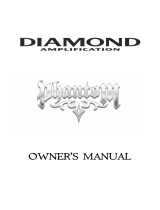Table of Contents
Table of Contents..............................................................................................................................................................v!
Introduction ......................................................................................................................................................................1!
Rack Gizmo Features..............................................................................................................................................................................................1!
Front Panel ........................................................................................................................................................................2!
Rear Panel..........................................................................................................................................................................3!
Controls and Connectors......................................................................................................................................................................................4!
Front Panel.................................................................................................................................................................................................................4!
Rear Panel...................................................................................................................................................................................................................4!
Special Features................................................................................................................................................................7!
Audio Buffer ..............................................................................................................................................................................................................7!
Click Stopper.............................................................................................................................................................................................................7!
Front Panel MIDI Connector................................................................................................................................................................................7!
Function Switching a.k.a. Controlling Your Amp.........................................................................................................................................8!
Stereo Loops .............................................................................................................................................................................................................8!
Setup Examples.................................................................................................................................................................9!
MIDI Usage ......................................................................................................................................................................14!
MIDI Continuous Controllers............................................................................................................................................................................ 14!
Bank Selection....................................................................................................................................................................................................... 15!
Backing Up Your Settings: SysEx Dump....................................................................................................................................................... 15!
Setup Mode .....................................................................................................................................................................16!
Selecting MIDI Channel and MIDI Options.................................................................................................................................................. 16!
MIDI Channels................................................................................................................................................................................................... 16!
Continuous Controller Ranges ................................................................................................................................................................... 16!
GCX Compatibility Mode.............................................................................................................................................................................. 17!
CC Disable .......................................................................................................................................................................................................... 17!
Bank Select Enable.......................................................................................................................................................................................... 17!
Saving MIDI Channel and Options ............................................................................................................................................................ 17!
Invert Mode ............................................................................................................................................................................................................ 17!
Momentary Mode ................................................................................................................................................................................................ 17!
Group Mode ........................................................................................................................................................................................................... 18!
Quick Setup Buttons............................................................................................................................................................................................ 18!
Factory Reset.......................................................................................................................................................................................................... 19!
Troubleshooting .............................................................................................................................................................20!
Grounding Issues ............................................................................................................................................................21!
Specifications ..................................................................................................................................................................22!
Amp Connector Pinout ...................................................................................................................................................................................... 22!
Front Panel MIDI Connector............................................................................................................................................................................. 23!
Rack Gizmo MIDI Implementation Chart ......................................................................................................................24!
Warranty..........................................................................................................................................................................27!

























